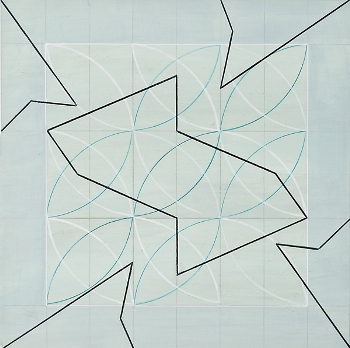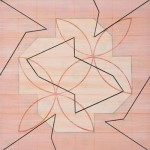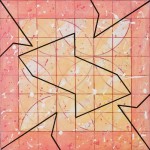By DAVID O. AVRUCH
Anne Krinsky's show at the Soprafina Gallery, “Diagonal Thinking,” offers 16 works on paper and panel and a friendly, accessible aesthetic. Fourteen of the works, from whose titles the show draws its name, are variations on a theme: gridded and polychromatic backgrounds overlaid with the black skeleton of a four-pronged pinwheel with the black outline of an irregular octagon carved from the work’s center. The variations come in palette and gestural texture methods of application and bells and whistles such as polka dots, large beige diamonds, grids of rectangles or squares in addition to compass-perfect, end-pointed ellipses that form flower petals.. The show's other two works, Arabesque 3 and Arabesque 4, are more painterly and figurative.
The main strength of the 14 Diagonal Thinking paintings is their clarity of perceptual depth: from foreground to back, five or six observable layers draw the eye in and through the works, all the way to their base grid. In Diagonal Thinking 22, a taupe background founds an ash-gray rectangular grid while a lighter taupe fills an inner square that the grid delineates. Inside the square, elliptical petals in aqua, white and green stream corner to corner to form too-perfect four-petaled flowers. This internal geometrical logic is then sublimated to the black pinwheel skeleton, leaving a painting of kaleidoscopic cuteness and palpable craftsmanship. Though carefully plotted, Krinsky's art approximates writer Italo Calvino's conception of lightness: agile, subtle, multiplex and buoyant, enhanced by juxtaposition that exists both within each painting, via the journey from grid to skeleton, and between the paintings, through their tonal and formal variations.
Also interesting is Krinsky's use of the grid: 13 of the 14 paintings in the Diagonal Thinking series utilize a grid as their perceptual point of embarkation; seven are gridded in small squares, three in rectangles, two in large squares, with the last one ostensibly gridless. In the history of painting, the grid does not appear as subject matter until the early 20th century. Writing in 1978, critic Rosalind Krauss declared grids “the emblems of modernity,” asserting, “By 'discovering' the grid, Cubism, De Stijl, Mondrian, Malevich... landed in a place that was out of reach of everything that went before. Which is to say, they landed in the present, and everything else was declared to be the past.” Less monumental than Malevich's and less vivid than Mondrian's, Krinsky's work makes no claims to such portentousness and perhaps has more in common with that of Agnes Martin: when asked about the difference between Martin's work and a sheet of graph paper, artist Richard Tuttle characterized it as “the difference between the loved line and the unloved line.”
Nevertheless, the two Arabesque paintings do come as a welcome change after the fourteen Diagonal Thinking works. Here, Krinsky abandons the grid in favor of a (seemingly) more spontaneous palimpsest, featuring spattered paint and a floral motif. In Arabesque 3, a white background supports a row of dots the size of quarters along the bottom in orange, green-blue and taupe. Cookie-cutter eight-petaled flower shapes float above them, while occupying the center of the canvas is a black delineation of two floppy flower blossoms, possibly hibiscus. Topping this heap, from the upper left side of the canvas to the right of the bottom side, run the pointed ellipses. Here in turquoise, they run end to end in perfect arcs to form two more flowers. The work’s fun, flexible aesthetic makes theDiagonal Thinking series seem staid and is – possibly due to its subliminal evocation of Funfetti cake – a painting that leaves a positive, excited impression.
Despite its individual successes, "Diagonal Thinking" remains underwhelming as a show. Although there is incremental beauty to be enjoyed painting by painting, the overall modesty of the works, both on a physical and emotional level, renders the variations-on-a-theme concept a liability: there is too little at stake from one to the next. As a result, the emotional impact that does exist is submerged in the anticipation for something else, something new, something more, and, leaving the gallery, the sense of having missed a second room or crucial canvas further breaks the spell.
- Anne Krinsky, Diagonal Thinking 22, Acrylic and Pencil on Paper, 2007.
- Anne Krinsky, Diagonal Thinking 21, Acrylic and Pencil on Paper, 2007.
- Anne Krinsky, Diagonal Thinking 24, Acrylic and Pencil on Paper, 2007.
"Diagonal Thinking" is on view through at Soprafina Gallery through March 1.
All images are courtesy of the artist and Soprafina Gallery.







